Altitudinal Shifts as a Climate Resilience Strategy for Angelica sinensis Production in Its Primary Cultivation Region
Abstract
1. Introduction
2. Materials and Methods
2.1. Study Area
2.2. Data Preparation
2.3. Method
2.3.1. Spatial Distribution Mapping of Angelica sinensis Cultivation Areas
2.3.2. Influence of Environmental Variables on Angelica sinensis
2.3.3. Projections of Spatial Distribution and Yield of Angelica sinensis
3. Results
3.1. Spatiotemporal Dynamics of Angelica sinensis Cultivation
3.2. Impacts of Environmental Factors on the Spatial Distribution and Growth of Angelica sinensis
3.3. Projections of Suitable Cultivation Areas and Crop Yields Under Future Climate Scenarios
4. Discussion
4.1. Spatial Distribution Mapping of Angelica sinensis
4.2. Impacts of Climate Change on Angelica sinensis
4.3. Suggestions for Angelica sinensis Cultivation and Management
4.4. Limitations and Prospects
5. Conclusions
Supplementary Materials
Author Contributions
Funding
Data Availability Statement
Conflicts of Interest
Abbreviations
| AP | Annual precipitation |
| RSP | Rainy season precipitation |
| DMP | Driest month precipitation |
| MAT | Mean annual temperature |
| WMT | Warmest month temperature |
| CMT | Coldest month temperature |
| WMP | Wettest month precipitation |
| MARH | Mean annual relative humidity |
| RST | Rainy season temperature |
| AL | Altitude |
| SL | Slope |
| AS | Aspect |
| SOC | Soil organic carbon |
| pH | Soil pH |
| ST | Soil texture |
| SWC | Soil water content |
| TN | Total nitrogen |
| PD | Population density |
| RD | Road density |
| MD | Market distance |
References
- Rahbek, C.; Borregaard, M.K.; Colwell, R.K.; Dalsgaard, B.; Holt, B.G.; Morueta-Holme, N.; Nogues-Bravo, D.; Whittaker, R.J.; Fjeldså, J. Humboldt’s enigma: What causes global patterns of mountain biodiversity? Science 2019, 365, 1108–1113. [Google Scholar] [CrossRef] [PubMed]
- Ly, A.; Geschke, J.; Snethlage, M.A.; Stauffer, K.L.; Nussbaumer, J.; Schweizer, D.; Diffenbaugh, N.S.; Fischer, M.; Urbach, D. Subnational biodiversity reporting metrics for mountain ecosystems. Nat. Sustain. 2023, 6, 1547–1551. [Google Scholar] [CrossRef]
- Xie, Z.; Zhang, Q.Q.; Jiang, C.; Yao, R.B. Cropland compensation in mountainous areas in China aggravates non-grain production: Evidence from Fujian Province. Land Use Policy 2024, 138, 107026. [Google Scholar] [CrossRef]
- Holmelin, N.B. National specialization policy versus farmers? priorities: Balancing subsistence farming and cash cropping in Nepal. J. Rural Stud. 2021, 83, 71–80. [Google Scholar] [CrossRef]
- Özdemir, E.; Alpinar, K. An ethnobotanical survey of medicinal plants in western part of central Taurus Mountains: Aladaglar (Nigde—Turkey). J. Ethnopharmacol. 2015, 166, 53–65. [Google Scholar] [CrossRef]
- Shan, Z.J.; Ye, J.F.; Hao, D.C.; Xiao, P.G.; Chen, Z.D.; Lu, A.M. Distribution patterns and industry planning of commonly used traditional Chinese medicinal plants in China. Plant Divers. 2022, 44, 255–261. [Google Scholar] [CrossRef]
- Wei, W.L.; Zeng, R.; Gu, C.M.; Qu, Y.; Huang, L.F. Angelica sinensis in China-A review of botanical profile, ethnopharmacology, phytochemistry and chemical analysis. J. Ethnopharmacol. 2016, 190, 116–141. [Google Scholar] [CrossRef]
- Sun, Y.M.; Gao, Y.S.; Zhou, L.; Lu, Y.X.; Zong, Y.L.; Zhu, H.Y.; Tang, Y.; Zheng, F.J.; Sun, Y.; Li, Y.H. A multi-target protective effect of Danggui-Shaoyao-San on the vascular endothelium of atherosclerotic mice. BMC Complement. Med. 2023, 23, 60. [Google Scholar] [CrossRef]
- Li, S.M.; Chiu, T.Y.; Jin, X.; Cao, D.; Xu, M.; Zhu, M.Z.; Zhou, Q.; Liu, C.; Zong, Y.; Wang, S.J.; et al. Integrating genomic and multiomic data for provides insights into the evolution and biosynthesis of pharmaceutically bioactive compounds. Commun. Biol. 2023, 6, 1198. [Google Scholar] [CrossRef]
- Zheng, S.H.; Ren, W.G.; Huang, L.F. Geoherbalism evaluation of Radix based on electronic nose. J. Pharmaceut. Biomed. 2015, 105, 101–106. [Google Scholar] [CrossRef]
- Li, M.L.; Li, J.; Cao, X.L.; Wang, Q.L.; Li, M.F.; Wei, J.H. Analytic research on current situation of early bolting rate and component factors of economic benefits of Gansu province genuine medicinal herbs Angelica sinensis. Grassl. Turf. 2022, 42, 152–158. [Google Scholar]
- Zhao, J.; Zhong, Y.F.; Hu, X.; Wei, L.F.; Zhang, L.P. A robust spectral-spatial approach to identifying heterogeneous crops using remote sensing imagery with high spectral and spatial resolutions. Remote Sens. Environ. 2020, 239, 111605. [Google Scholar] [CrossRef]
- Wu, Y.J.; Peng, Z.Y.; Hu, Y.M.; Wang, R.J.; Xu, T.S. A dual-branch network for crop-type mapping of scattered small agricultural fields in time series remote sensing images. Remote Sens. Environ. 2025, 316, 114497. [Google Scholar] [CrossRef]
- Henrys, P.A.; Jarvis, S.G. Integration of ground survey and remote sensing derived data: Producing robust indicators of habitat extent and condition. Ecol. Evol. 2019, 9, 8104–8112. [Google Scholar] [CrossRef]
- Bueno, I.T.; Antunes, J.F.G.; Reis, A.A.D.; Werner, J.P.S.; Toro, A.P.S.G.D.D.; Figueiredo, G.K.D.A.; Esquerdo, J.C.D.M.; Lamparelli, R.A.C.; Coutinho, A.C.; Magalha, P.S.G. Mapping integrated crop-livestock systems in Brazil with planetscope time series and deep learning. Remote Sens. Environ. 2023, 299, 113886. [Google Scholar] [CrossRef]
- Jeong, S.; Ko, J.; Ban, J.O.; Shin, T.; Yeom, J.M. Deep learning-enhanced remote sensing-integrated crop modeling for rice yield prediction. Ecol. Inform. 2024, 84, 102886. [Google Scholar] [CrossRef]
- Wozniak, E.; Rybicki, M.; Kofman, W.; Aleksandrowicz, S.; Wojtkowski, C.; Lewinski, S.; Bojanowski, J.; Musial, J.; Milewski, T.; Slesinski, P.; et al. Multi-temporal phenological indices derived from time series Sentinel-1 images to country-wide crop classification. Int. J. Appl. Earth Obs. 2022, 107, 102683. [Google Scholar] [CrossRef]
- Zhan, P.; Zhu, W.Q.; Li, N. An automated rice mapping method based on flooding signals in synthetic aperture radar time series. Remote Sens. Environ. 2021, 252, 112112. [Google Scholar] [CrossRef]
- Li, Z.H.; Zhao, Y.; Taylor, J.; Gaulton, R.; Jin, X.L.; Song, X.Y.; Li, Z.H.; Meng, Y.; Chen, P.F.; Feng, H.K.; et al. Comparison and transferability of thermal, temporal and phenological-based in-season predictions of above-ground biomass in wheat crops from proximal crop reflectance data. Remote Sens. Environ. 2022, 273, 112967. [Google Scholar] [CrossRef]
- Wei, F.F.; Lv, R.; He, W.W.; Wang, L.; Cheng, X.; Zhang, X.B.; Shi, T.T.; Jin, L. Extraction of distribution information of Angelicae sinensis plants in Weiyuan county based on remote sensing technology. China J. Chin. Mater. Med. 2019, 44, 4125–4128. [Google Scholar]
- Xu, X.Q.; Zhu, T.T.; Shi, T.T.; Chen, J.; Jin, L. Quality suitability regionalization analysis of Angelica sinensis in Gansu, China. PLoS ONE 2020, 15, e0243750. [Google Scholar] [CrossRef] [PubMed]
- Dong, H.; Li, M.L.; Jin, L.; Xie, X.R.; Li, M.F.; Wei, J.H. Cool Temperature Enhances Growth, Ferulic Acid and Flavonoid Biosynthesis While Inhibiting Polysaccharide Biosynthesis in Angelica sinensis. Molecules 2022, 27, 320. [Google Scholar] [CrossRef] [PubMed]
- Fan, Q.; Zhang, Y.Y.; Chen, H.P.; Lin, X.Y.; Xia, P.F.; Sun, Y.J.; Zhao, L.; Luo, J.; Yang, F.X.; Li, S.H. Influence of ecological factors on the quality of Angelica sinensis based on OPLS model. Chin. Tradit. Pat. Med. 2021, 43, 1226–1230. [Google Scholar]
- Liu, B.; Rao, B.Y.; Qian, C.; Wu, Z.J. Effect on different irrigation treatments on growth, yield and quality of Angelica sinensis. Mod. Agric. Sci. Technol. 2013, 2, 77–82. [Google Scholar]
- Xi, S.Y.; Guo, X.D.; Ma, X.H.; Jin, L. Impacts of climate change on the suitable habitat of and analysis of its drivers in China. Sci. Rep. 2025, 15, 3508. [Google Scholar] [CrossRef]
- Yu, P.; Yan, X.W.; Hong, J.S.; Li, D.C.; Xiong, F.; Bai, R.B.; Yang, J.; Guo, L.P. Geographical origins of using functional compounds and multielement with machine learning-based fusion approaches. Food Chem. 2025, 471, 14274. [Google Scholar] [CrossRef]
- Jin, W.J.; Zhang, Y.B.; Su, X.S.; Xie, Z.K.; Wang, R.Y.; Du, Z.P.; Wang, Y.J.; Qiu, Y. Genetic diversity analysis of lychnis mottle virus and first identification of Angelica sinensis infection. Heliyon 2023, 9, e17006. [Google Scholar] [CrossRef]
- Omia, E.; Bae, H.; Park, E.; Kim, M.S.; Baek, I.; Kabenge, I.; Cho, B.K. Remote Sensing in Field Crop Monitoring: A Comprehensive Review of Sensor Systems, Data Analyses and Recent Advances. Remote Sens. 2023, 15, 354. [Google Scholar] [CrossRef]
- Pott, L.P.; Amado, T.J.C.; Schwalbert, R.A.; Corassa, G.M.; Ciampitti, I.A. Crop type classification in Southern Brazil: Integrating remote sensing, crop modeling and machine learning. Comput. Electron. Agric. 2022, 201, 107320. [Google Scholar] [CrossRef]
- Zhao, R.M.; Chen, Y.; Guo, F.X.; Wang, Y.; Zhang, S.Z.; Wang, R.Q. Comparative study on distributed feature of wild Angelica sinensis resources and the difference in growth characteristics with its cultivars native to Min County of Gansu. Acta Pratac. Sin. 2014, 23, 29–37. [Google Scholar]
- Zhang, H.Y.; Bi, W.G.; Yu, Y.; Liao, W.B. Angelica sinensis (Oliv.) Diels in China: Distribution, cultivation, utilization and variation. Genet. Resour. Crop Evol. 2012, 59, 607–613. [Google Scholar] [CrossRef]
- Wang, F.; Yuan, X.Z.; Sun, Y.J.; Liu, Y.H. Species distribution modeling based on MaxEnt to inform biodiversity conservation in the Central Urban Area of Chongqing Municipality. Ecol. Indic. 2024, 158, 111491. [Google Scholar] [CrossRef]
- Phillips, S.J.; Anderson, R.P.; Schapire, R.E. Maximum entropy modeling of species geographic distributions. Ecol. Model. 2006, 190, 231–259. [Google Scholar] [CrossRef]
- Ghareghan, F.; Ghanbarian, G.; Pourghasemi, H.R.; Safaeian, R. Prediction of habitat suitability of L. species using artificial intelligence techniques. Ecol. Indic. 2020, 112, 106096. [Google Scholar] [CrossRef]
- Morales, N.S.; Fernández, I.C.; Baca-González, V. MaxEnt’s parameter configuration and small samples: Are we paying attention to recommendations? A systematic review. PeerJ 2017, 5, e3093. [Google Scholar] [CrossRef]
- Radosavljevic, A.; Anderson, R.P. Making better Maxent models of species distributions: Complexity, overfitting and evaluation. J. Biogeogr. 2014, 41, 629–643. [Google Scholar] [CrossRef]
- Zhang, Q.Z.; Wei, H.Y.; Liu, J.; Zhao, Z.F.; Ran, Q.; Gu, W. A Bayesian network with fuzzy mathematics for species habitat suitability analysis: A case with limited Angelica sinensis (Oliv.) Diels data. Ecol. Model. 2021, 15, 109560. [Google Scholar] [CrossRef]
- Wang, X.; Yuan, Q.J.; Sun, K.; Guo, Z.X.; Chi, X.L.; Huang, L.Q. Population characteristics and threat association of wild Angelica sinensis in Gansu province. China J. Chin. Mater. Med. 2019, 44, 2987–2995. [Google Scholar]
- Lobo, J.M.; Jiménez-Valverde, A.; Real, R. AUC: A misleading measure of the performance of predictive distribution models. Global Ecol. Biogeogr. 2008, 17, 145–151. [Google Scholar] [CrossRef]
- Benjamini, Y.; Hochberg, Y. Controlling the false discovery rate: A practical and powerful approach to multiple testing. J. R. Stat. Soc. B 1995, 57, 289–300. [Google Scholar] [CrossRef]
- Gutiérrez-Hernández, O.; García, L.V. Uncovering True Significant Trends in Global Greening. Remote Sens. Appl. Soc. Environ. 2025, 37, 10137. [Google Scholar] [CrossRef]
- Li, H.W.; Li, Z.; Chen, Y.N.; Liu, Y.C.; Hu, Y.A.; Sun, F.; Kayumba, P.M. Projected meteorological drought over asian drylands under different CMIP6 scenarios. Remote Sens. 2021, 13, 4409. [Google Scholar] [CrossRef]
- Yang, Y.; Zhao, N. Future projections of compound temperature and precipitation extremes and corresponding population exposure over global land. Glob. Planet. Chang. 2024, 236, 104427. [Google Scholar] [CrossRef]
- Dinh, T.L.A.; Aires, F. Revisiting the bias correction of climate models for impact studies. Clim. Chang. 2023, 176, 140. [Google Scholar] [CrossRef]
- Khanal, S.; Kushal, K.C.; Fulton, J.P.; Shearer, S.; Ozkan, E. Remote Sensing in Agriculture-Accomplishments, Limitations, and Opportunities. Remote Sens. 2020, 12, 3783. [Google Scholar] [CrossRef]
- Graf, L.V.; Merz, Q.N.; Walter, A.; Aasen, H. Insights from field phenotyping improve satellite remote sensing based in-season estimation of winter wheat growth and phenology. Remote Sens. Environ. 2023, 299, 113860. [Google Scholar] [CrossRef]
- Zhu, S.D.; Guo, L.P.; Cui, Y.J.; Xiao, R.L.; Yu, Z.X.; Jin, Y.; Fu, R.Q.; Zhang, J.H.; Xu, T.R.; Chen, J.B.; et al. Quality suitability modeling of volatile oil in Chinese Materia Medica–Based on maximum entropy and independent weight coefficient method: Case studies of Atractylodes lancea, Angelica sinensis, Curcuma longa and Atractylodes macrocephala. Ind. Crop. Prod. 2019, 142, 111807. [Google Scholar] [CrossRef]
- Wu, P.; Ding, Y.H.; Liu, Y.J.; Li, X.C. The characteristics of moisture recycling and its impact on regional precipitation against the background of climate warming over Northwest China. Int. J. Climatol. 2019, 39, 5241–5255. [Google Scholar] [CrossRef]
- Yang, L.; Tian, J.X.; Fu, Y.H.; Zhu, B.; He, X.; Gao, M.K.; Odamtten, M.T.; Kong, R.; Zhang, Z.X. Will the arid and semi-arid regions of Northwest China become warmer and wetter based on CMIP6 models? Hydrol. Res. 2022, 53, 29–50. [Google Scholar] [CrossRef]
- Zhao, P.; He, Z.B. Temperature change characteristics in Gansu Province of China. Atmosphere 2022, 13, 728. [Google Scholar] [CrossRef]
- Li, M.F.; Li, J.; Wei, J.H.; Paré, P.W. Transcriptional controls for early bolting and flowering in Angelica sinensis. Plants 2021, 10, 1931. [Google Scholar] [CrossRef]
- Tan, Z.K.; Yuan, Y.H.; Huang, S.Y.; Ma, Y.X.; Hong, Z.Y.; Wang, Y.; Wu, X.Y.; Li, Z.X.; Ye, J.H.; Zhang, L.Y. Geographical distribution and predict potential distribution of L. genus. Environ. Sci. Pollut. R. 2023, 30, 46562–46573. [Google Scholar] [CrossRef]
- Yan, H.; Duan, J.A.; Wang, R.Q.; Guo, Z.X.; Qian, D.W.; Song, B.S.; He, Z.Q.; Gao, H.Y. Study on prediction model of Angelicae sinensis yield per unit in Min County. J. Chin. Med. Mater. 2012, 35, 511–514. [Google Scholar]
- Zhang, T.; Li, Q. Analysis of climatic resources for Angelica sinensis cultivation in Min County. China South. Agric. Mach. 2023, 54, 54–56. [Google Scholar]
- Li, L.H.; Zhang, Y.; Zhou, T.J.; Wang, K.C.; Wang, C.; Wang, T.; Yuan, L.W.; An, K.X.; Zhou, C.H.; Lü, G.N. Mitigation of China’s carbon neutrality to global warming. Nat. Commun. 2022, 13, 5315. [Google Scholar] [CrossRef]
- Li, B.Y.; Liu, D.W.; Yu, E.T.; Wang, L.X. Warming-and-wetting trend over the China’s drylands: Observational evidence and future projection. Glob. Environ. Chang. 2024, 86, 102826. [Google Scholar] [CrossRef]
- You, Q.L.; Cai, Z.Y.; Wu, F.Y.; Jiang, Z.H.; Pepin, N.; Shen, S.S.P. Temperature dataset of CMIP6 models over China: Evaluation, trend and uncertainty. Clim. Dyn. 2021, 57, 17–35. [Google Scholar] [CrossRef]
- Song, X.Y.; Xu, M.; Kang, S.C.; Wang, R.J.; Wu, H. Evaluation and projection of changes in temperature and precipitation over Northwest China based on CMIP6 models. Int. J. Climatol. 2024, 44, 5039–5056. [Google Scholar] [CrossRef]
- Zhu, Z.; Piao, S.; Myneni, R.B.; Huang, M.; Zeng, Z.; Canadell, J.G.; Ciais, P.; Sitch, S.; Friedlingstein, P.; Arneth, A.; et al. Greening of the Earth and its drivers. Nat. Clim. Chang. 2016, 6, 791–795. [Google Scholar] [CrossRef]
- Piao, S.; Wang, X.; Park, T.; Chen, C.; Lian, X.; He, Y.; Bjerke, J.W.; Chen, A.; Ciais, P.; Tømmervik, H.; et al. Characteristics, drivers and feedbacks of global greening. Nat. Rev. Earth Environ. 2020, 1, 14–27. [Google Scholar] [CrossRef]
- Tao, T.M.; Ma, L.B.; Liu, Y.; Tang, H.L.; Wang, X.; Wu, S.S. A systematic framework for rural resilience assessment in the rural Gansu Province, China. Environ. Impact Assess. Rev. 2025, 110, 110661. [Google Scholar] [CrossRef]
- Lu, Y.H.; Yan, L.J.; Li, J.; Liang, Y.L.; Yang, C.J.; Li, G.; Wu, J.Q.; Xu, H. Spatiotemporal evolution of county level ecological security based on an emergy ecological footprint model: The case of Dingxi, China. Ecol. Model. 2024, 490, 110661. [Google Scholar] [CrossRef]
- Lin, H.M.; Wu, Y.A.; Cao, Z.F.; Lv, S.L.; Mao, X.J. Influence of sun shade cultivation on premature bolting in Angelica sinensis and growth environment factors. Chin. J. Exp. Tradit. Med. Formulae 2010, 16, 79–83. [Google Scholar]
- Peña-Arancibia, J.L.; Ahmad, M.U.D.; Yu, Y.Y. Remote sensing characterisation of cropping systems and their water use to assess irrigation management from field to canal command scale. Agric. Water Manag. 2025, 311, 109374. [Google Scholar] [CrossRef]
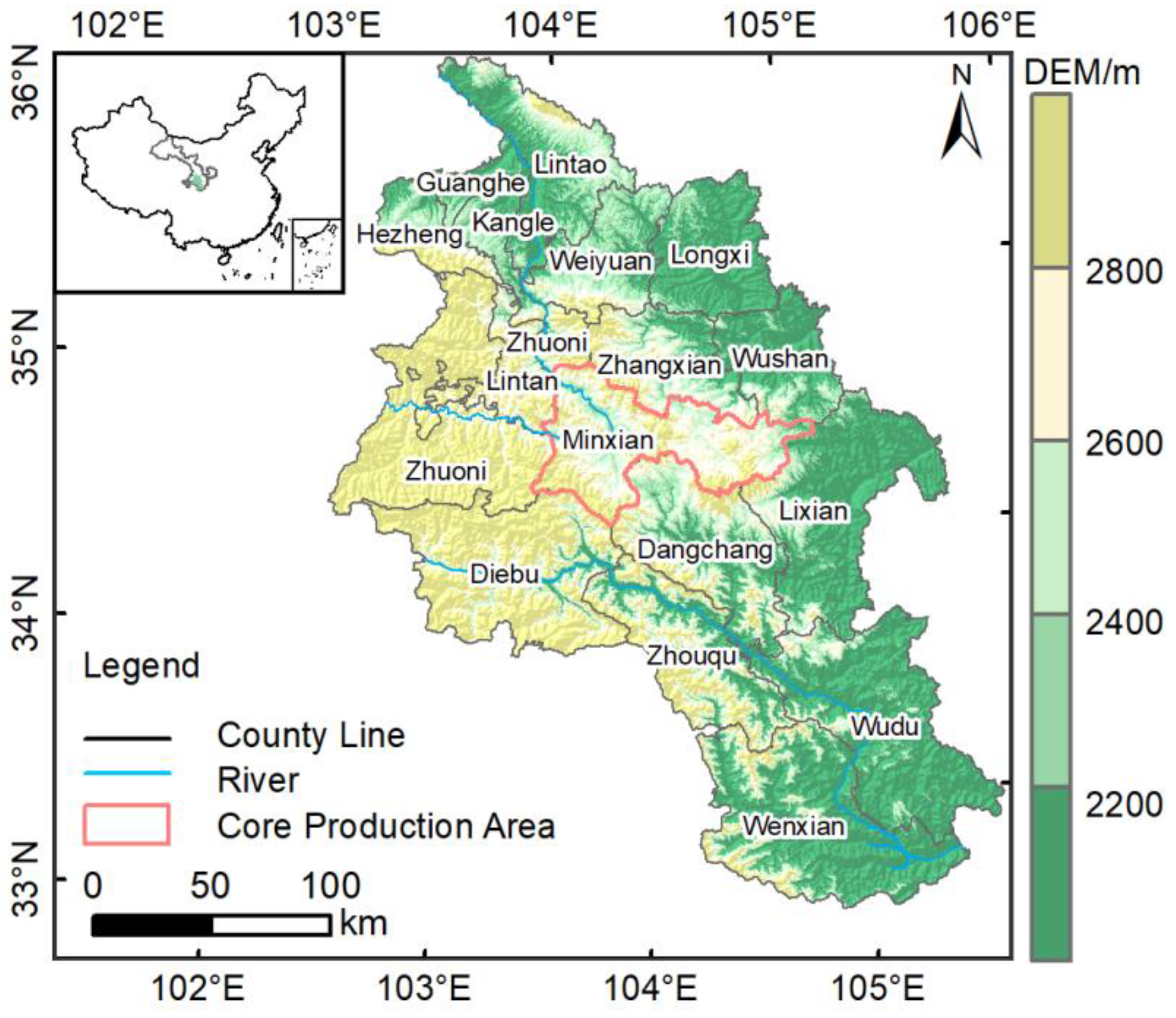
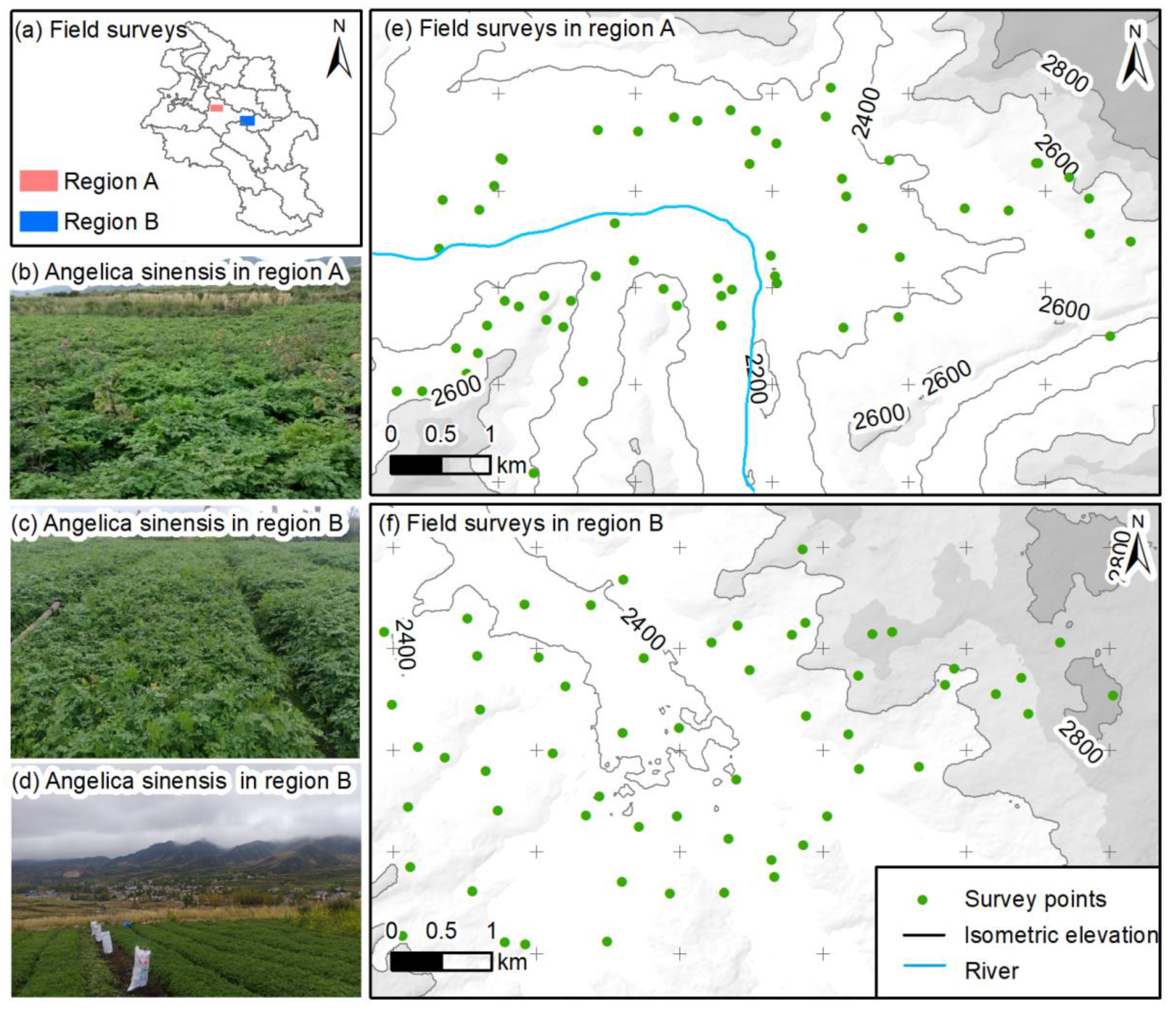
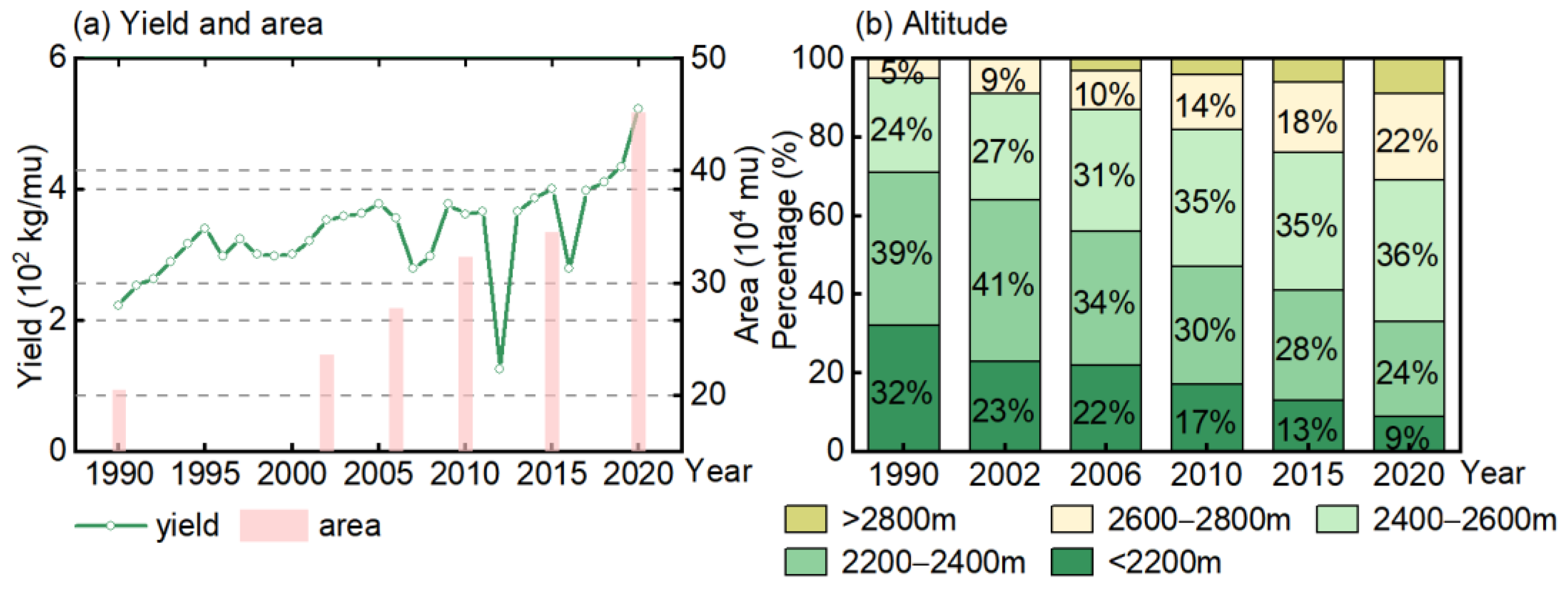
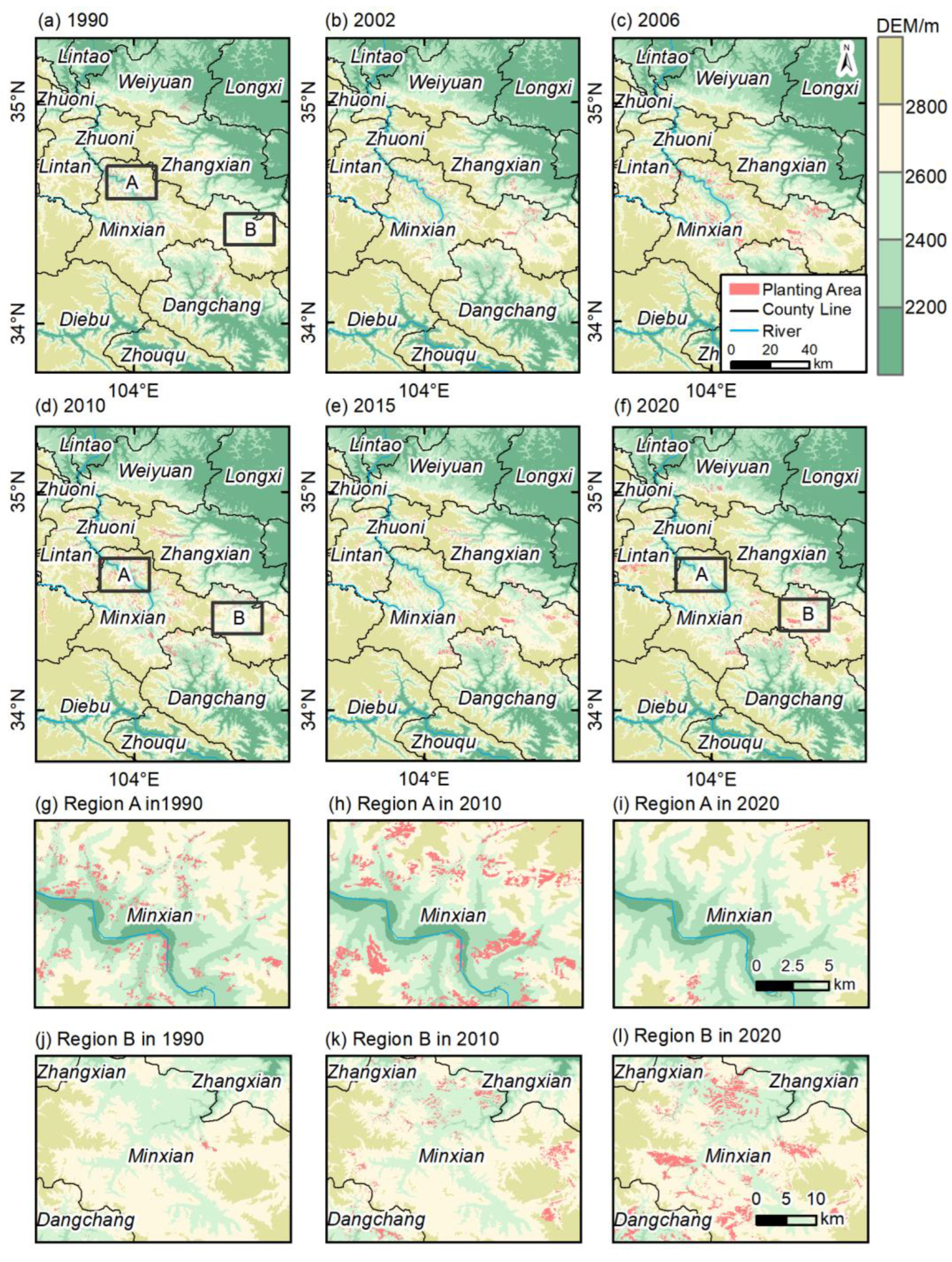
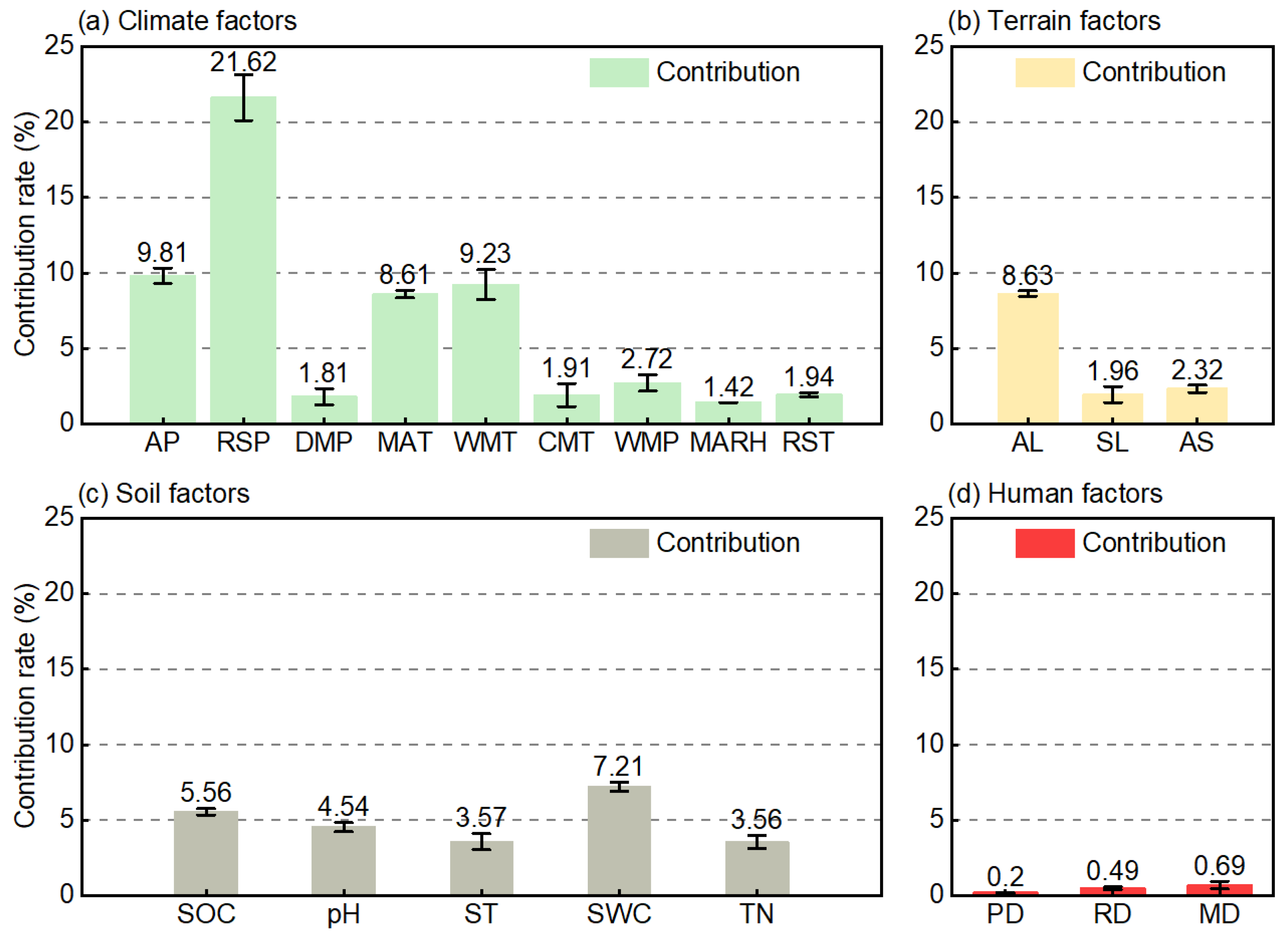

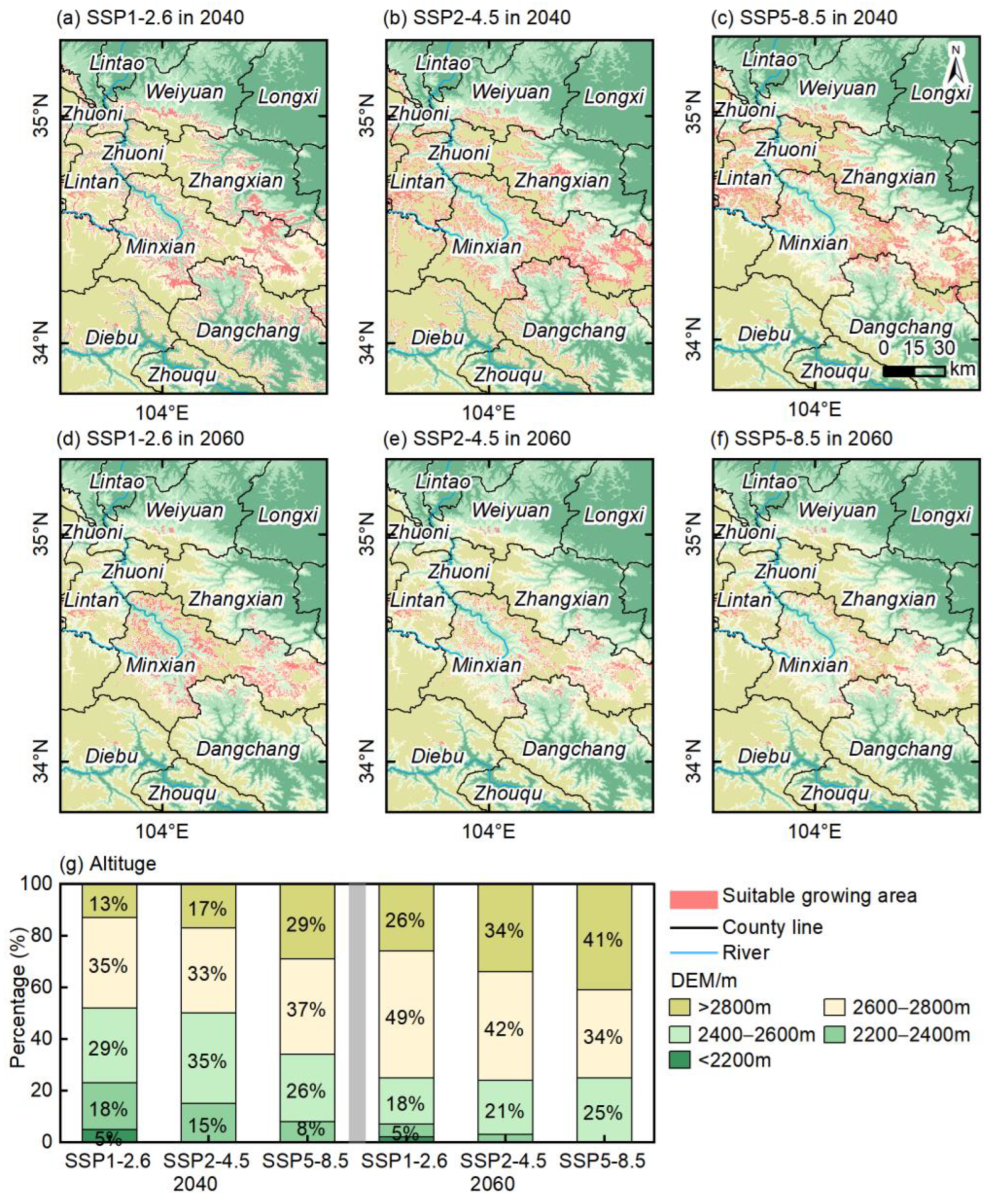
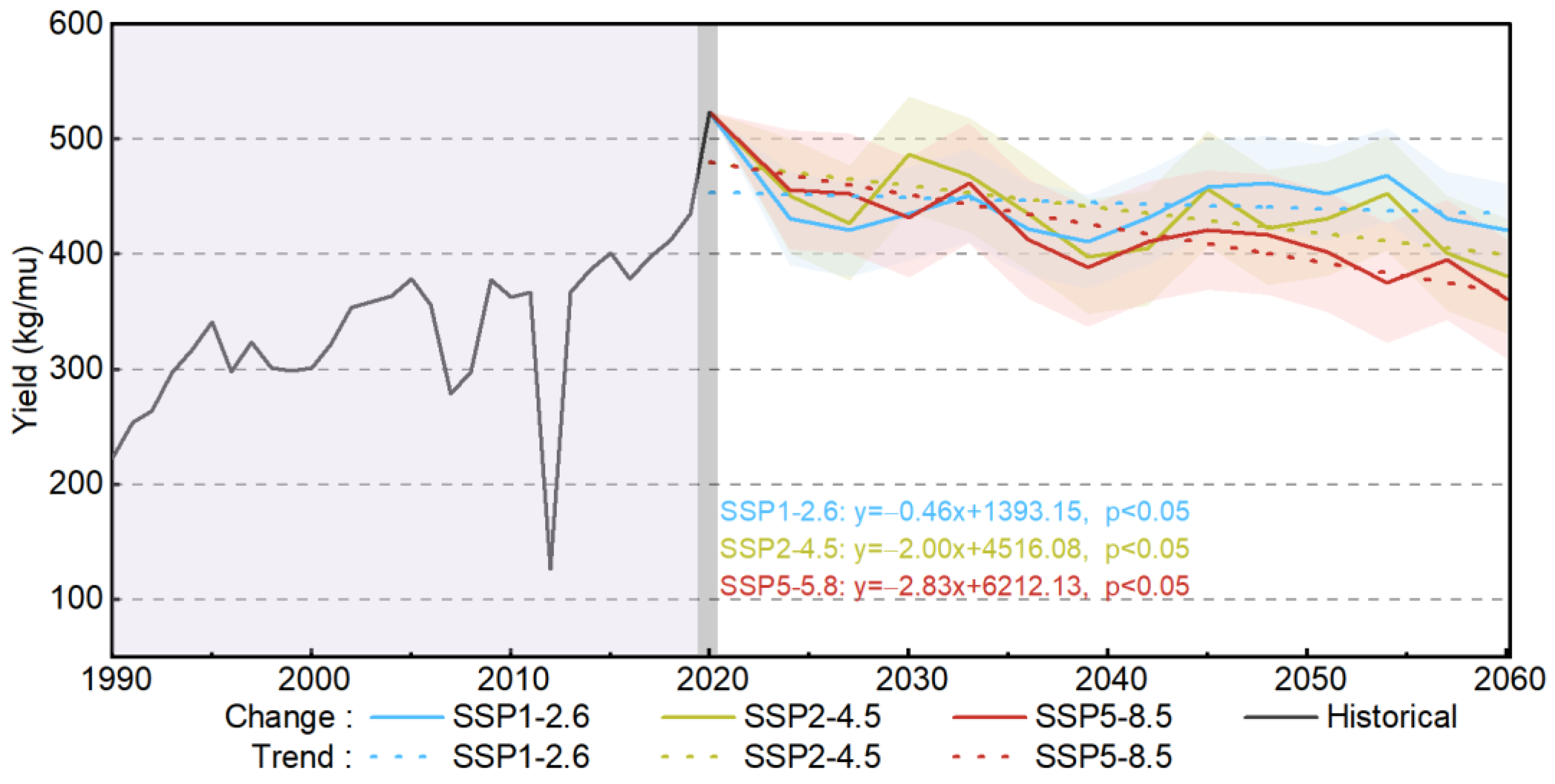
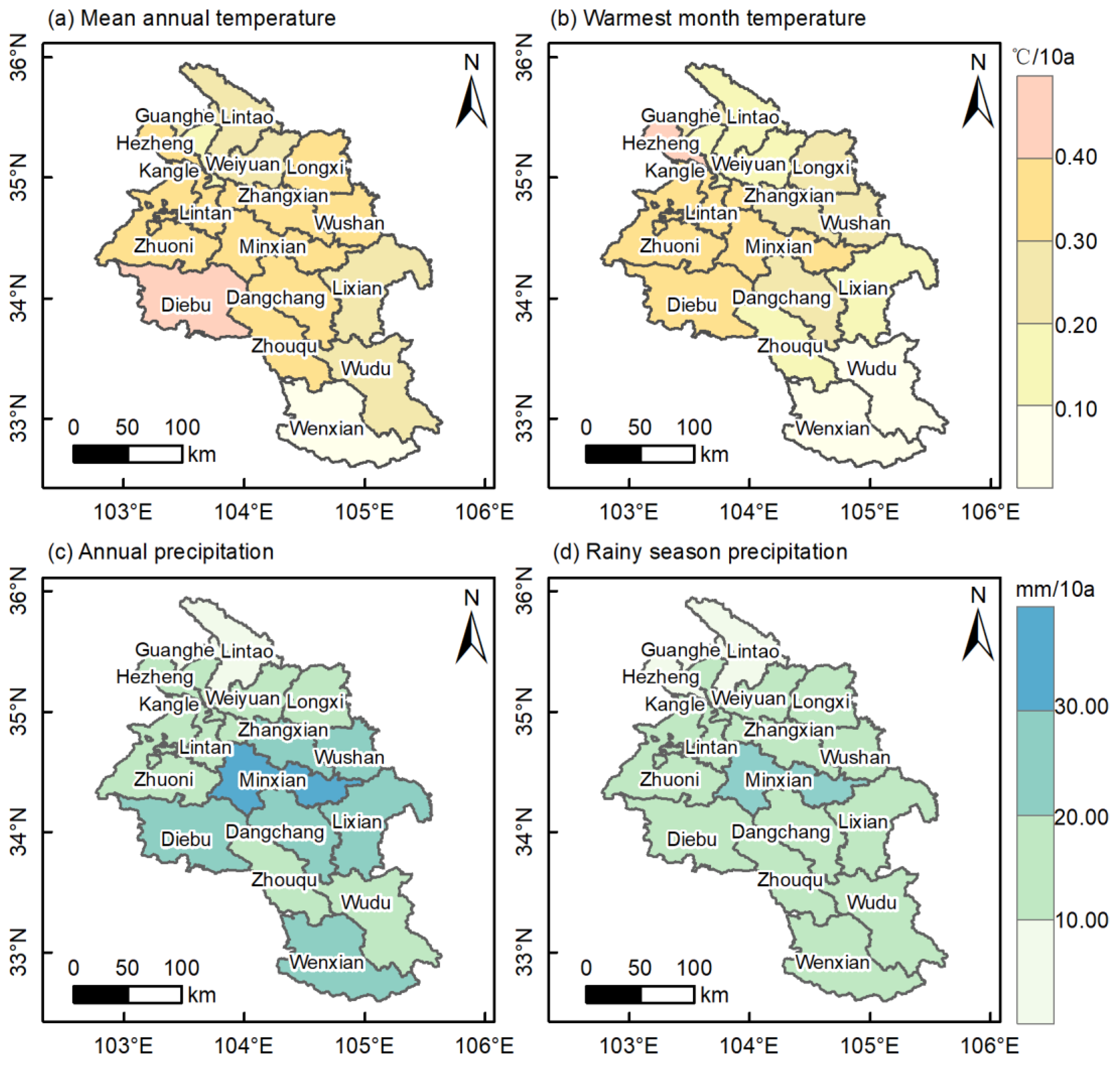
Disclaimer/Publisher’s Note: The statements, opinions and data contained in all publications are solely those of the individual author(s) and contributor(s) and not of MDPI and/or the editor(s). MDPI and/or the editor(s) disclaim responsibility for any injury to people or property resulting from any ideas, methods, instructions or products referred to in the content. |
© 2025 by the authors. Licensee MDPI, Basel, Switzerland. This article is an open access article distributed under the terms and conditions of the Creative Commons Attribution (CC BY) license (https://creativecommons.org/licenses/by/4.0/).
Share and Cite
Li, Z.; Li, D.; Peng, H.; Xu, R.; Zhu, Z. Altitudinal Shifts as a Climate Resilience Strategy for Angelica sinensis Production in Its Primary Cultivation Region. Remote Sens. 2025, 17, 2085. https://doi.org/10.3390/rs17122085
Li Z, Li D, Peng H, Xu R, Zhu Z. Altitudinal Shifts as a Climate Resilience Strategy for Angelica sinensis Production in Its Primary Cultivation Region. Remote Sensing. 2025; 17(12):2085. https://doi.org/10.3390/rs17122085
Chicago/Turabian StyleLi, Zhengdong, Dajing Li, Hongxia Peng, Ruixuan Xu, and Zaichun Zhu. 2025. "Altitudinal Shifts as a Climate Resilience Strategy for Angelica sinensis Production in Its Primary Cultivation Region" Remote Sensing 17, no. 12: 2085. https://doi.org/10.3390/rs17122085
APA StyleLi, Z., Li, D., Peng, H., Xu, R., & Zhu, Z. (2025). Altitudinal Shifts as a Climate Resilience Strategy for Angelica sinensis Production in Its Primary Cultivation Region. Remote Sensing, 17(12), 2085. https://doi.org/10.3390/rs17122085






